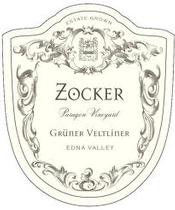Zocker, Edna Valley (California) Grüner Veltliner, Paragon Vineyard, 2012 ($20): The smile on my face as I opened a box of wine samples turned into a grin when I saw what was inside: Six white wines from Edna Valley, courtesy of Niven Family Wine Estates in San Luis Obispo and winemaker Christian Roguenant. These were not your typical California whites but an eclectic set of varietal wines that included Albariño, Grenache Blanc, Viognier and Grüner Veltliner along with Sauvignon Blanc and Pinot Gris. These grapes are just half the range that Roguenant grows in the Niven Family’s Paragon Vineyard, which has enjoyed a fine reputation for four decades, particularly for Pinot Noir.
Roguenant grows in the Niven Family’s Paragon Vineyard, which has enjoyed a fine reputation for four decades, particularly for Pinot Noir.
I liked all the wines, and for once it was difficult to decide which one to feature here. I chose the Grüner Veltliner because it is the most unusual of the grape varieties in California, produced by maybe a handful of wineries, and also because the wine itself captivated me.
Zocker is one of several brands that Niven Family Estates produces, each with a separate identity — such as Baileyana mainly for Burgundian varieties and Tangent for “unoaked, cool-climate alternative whites” of the sort in my sample box. The Zocker label covers only the Germanic varieties, Gruner Veltliner and Riesling, and takes its name (“Gambler,” in translation) from the high-risk prospect of growing Grüner in California. The brand debuted in 2010 with the release of the first vintage of Gruner Veltliner, the 2009.
The 1200-acre Paragon Vineyard currently has 12 acres of Grüner Veltliner, which represents 15 percent of the state’s tiny acreage of this variety. The site is cool because of its strong Pacific Ocean influence and enjoys an extended growing season that provides rich flavor development in the grapes along with high levels of acidity.
The 2012 Zocker Grüner Veltliner is a dry, full-bodied, unoaked white that combines lots of flavor with real weight and substance. The aroma is more reticent than the flavor at this stage, suggesting to me subtle notes of pear, honeydew melon and lime, while spicy, white-pepper notes emerge in your mouth, along with grapefruit peel, orange, and a stony mineral suggestion. Flavorful though it is, this wine is not a fruit bomb: Its viscous texture contrasts with high acidity to provide a structural interplay that is as interesting as the flavors themselves. If you focus just on the flavors, the wine seems delicious, crisp and light but when you pause to notice the structure, it gains gravitas.
This wine did not undergo malolactic fermentation (ML) and thus its acidity remains high and its flavors retain their clarity and focus. Aging in tank on the fermentation lees for about six months has contributed the richness of texture — the winemaker describes it as “creamy, soft texture” — that contrasts so nicely with the lean precision of the acidity and flavors. In terms of the wine’s alcohol content (13.5 percent), for once my tasting notes fail to comment, because the wine’s energy is driven by fruit and acidity rather than by alcohol.
I would enjoy this wine with foods that have fresh flavors, such as stir-fry dishes, salads, and summertime fare. Production is only 2649 cases. The bottle closure is a convenient screwcap.
90 Points
